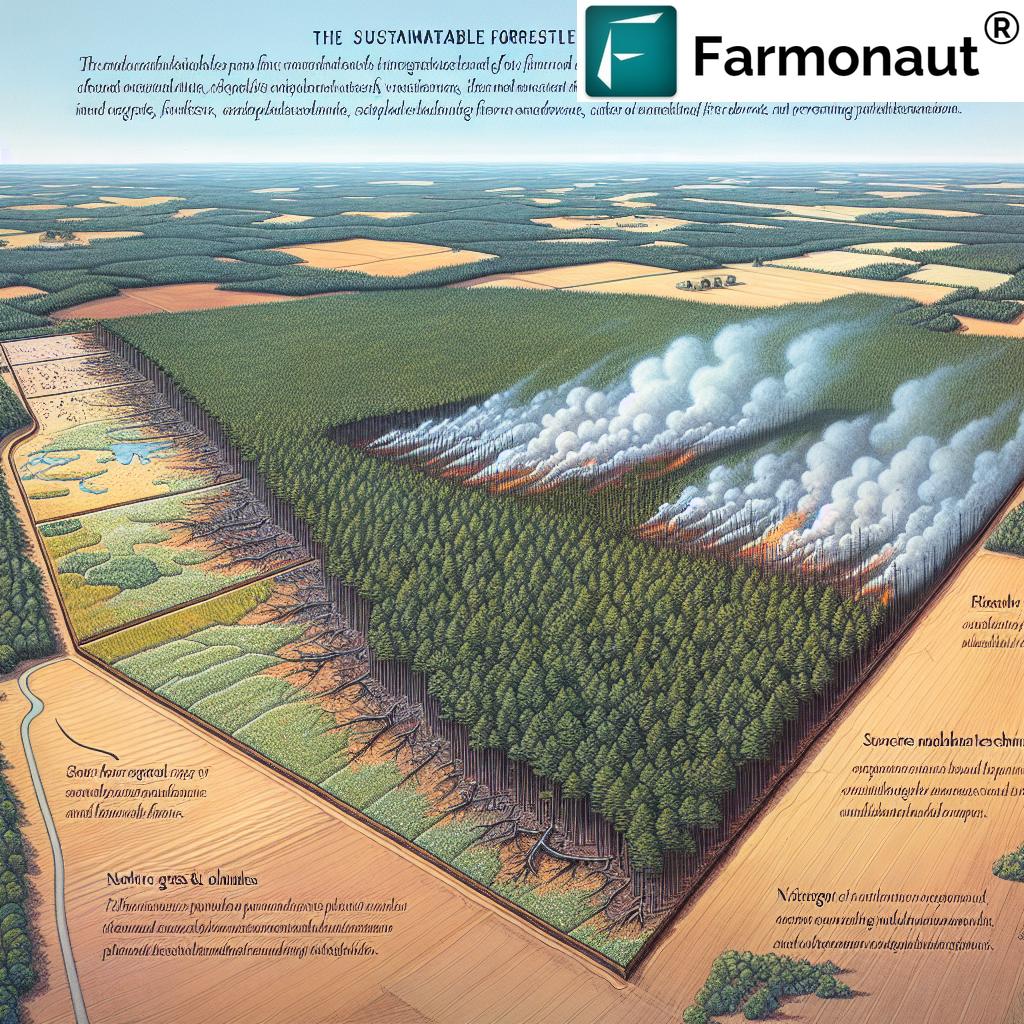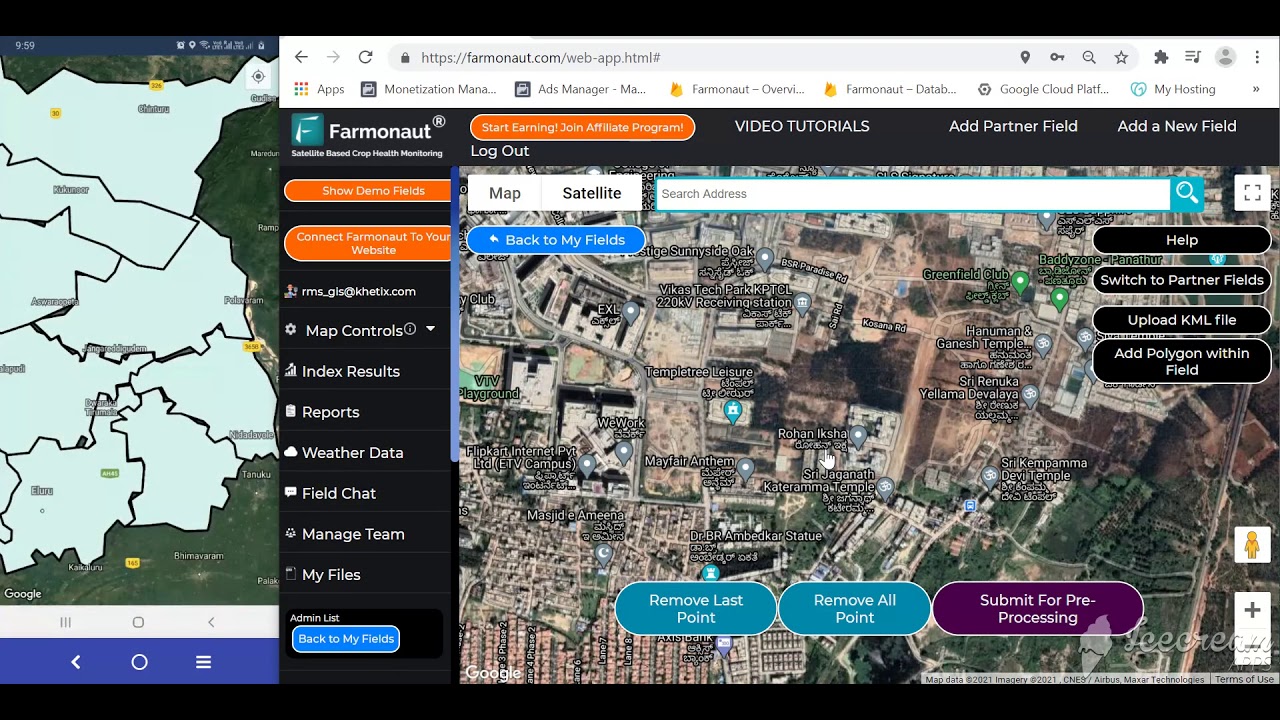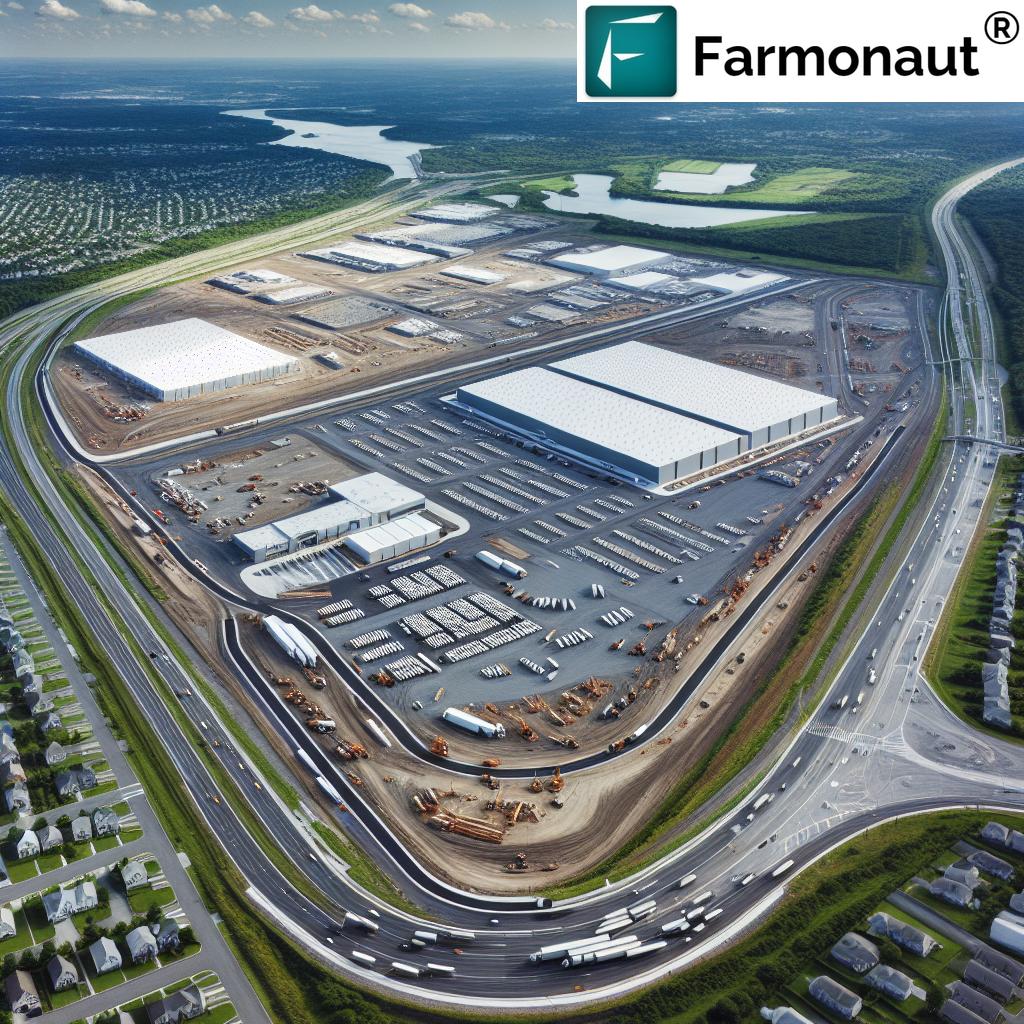Carolina Forest Firebreak Initiative: 7 Wildfire Tips
“Vegetated firebreaks can reduce wildfire spread by up to 60%, supporting both prevention and local biodiversity.”
Table of Contents
- Understanding Firebreaks: The Basics
- Role of Firebreaks in Agriculture and Forestry
- Carolina Forest Firebreak Initiative: 7 Wildfire Tips
- Types of Firebreaks: Benefits, Limitations & Environmental Impact Table
- Implementing Firebreaks in the Carolinas
- Firebreak Maintenance Practices & Challenges
- Farmonaut’s Role in Precision Firebreak Management
- Frequently Asked Questions
- Conclusion & Summary
Wildfires pose a formidable threat to forests, agricultural lands, and communities, particularly across fire-prone landscapes such as the Carolinas. Every year, lives, properties, and ecosystems are placed at risk, highlighting the necessity of proactive, science-based fire management strategies. At the heart of contemporary wildfire readiness and sustainable land management is the Carolina Forest Firebreak Initiative. Our collective goal is to not only slow wildfire progression, but also ensure that critical habitats, soil resources, and rural economies remain resilient and productive.
In this comprehensive post, we delve into the fundamental concepts of firebreaks, essential soil erosion control methods, and innovative vegetated firebreaks—all central to wildfire prevention and biodiversity support. Arranged around seven actionable tips, we highlight real-world practices, explain the science, and guide you, step by step, in establishing firebreaks for wildfire prevention within forests, agricultural settings, and beyond.
Understanding Firebreaks: The Basics
Let us begin by establishing what a firebreak is and its critical role in maintaining a balance between human activity, conservation, and wildfire prevention. At its core, a firebreak comprises cleared or treated strips of land, devoid of combustible materials, designed to halt or slow the progression of a fire. These barriers can take the form of natural features (rivers, roads) or be actively established using methods ranging from plowing and disking to mulching or selective clearing.
In the Carolinas, where wildlands, croplands, and settlements are closely connected, effective firebreaks serve as both practical fire-control solutions and as crucial ecological buffers. By impeding the spread of a wildfire, we not only defend critical resources and properties, but also use the firebreak as a tool for broader land stewardship.
- Focus Keyword: firebreaks (appears in the first 10% of content & subheading)
- Definition: Strips of land (natural or constructed), treated to prevent the spread of fires, by being devoid of flammable materials
- Dual Role: Safety and sustainability—protecting ecosystems and human communities
Role of Firebreaks in Agriculture and Forestry: Functions and Benefits
Firebreaks have evolved far beyond being mere barriers against fire. In our agricultural and forestry fire management efforts, they now offer a suite of advantages that support both wildlife habitat preservation techniques and modern sustainability goals. Here’s a closer look at their multifaceted contributions:
1. Wildlife Habitat Preservation Techniques
When firebreaks are properly managed, they act as habitats for native plant and animal species. Vegetated firebreaks can be planted with a carefully chosen mix of native grasses and legumes, providing valuable forage and cover for wild turkey, white-tailed deer, and many other populations. Seasonal disking and targeted planting can turn a simple firebreak into a vibrant corridor that supports food webs and biodiversity.
- Enhances growth of diverse plants that nourish wildlife
- Creates food plots and safe passages for key animal species
- Offers seasonal management: disking, mowing, and planting for optimal results
More on wildlife habitat preservation with firebreaks
2. Soil Erosion Control Methods
Soil erosion represents a long-term threat, especially in environments with exposed or disturbed surfaces. By relying on vegetated firebreaks, we stabilize the soil using strong root networks that bind soil particles and reduce the risk of soil loss during heavy rainfalls or post-fire events. In sloped areas, these measures are especially important for protecting nutrient-rich topsoil and nearby water bodies.
- Prevents soil runoff and sedimentation during storms
- Protects agricultural productivity by maintaining topsoil
- Supports sustainable land practices by reducing dependence on artificial erosion control structures
Read about soil erosion control methods in fire management
3. Livestock Grazing and Pastureland Enhancement
A less-recognized benefit of firebreaks is their use in agriculture as supplemental pastureland. Managed correctly, grazed firebreaks provide important forage for livestock, such as cattle, while keeping vegetation low and fire risk to a minimum. Our approach integrates fire prevention with efficient agricultural resource use, creating a dual-purpose landscape for safety and productivity.
- Reduces fuel loads through grazing and mowing
- Provides seasonal grazing opportunities
- Improves cost-efficiency for landowners by providing both forage and safety benefits
See how grazed firebreaks support fire and agriculture
4. Controlled Burns and Safe Fire Management
Controlled, or prescribed burns, are a proven method for reducing fuel loads in fire-prone areas. Firebreaks form the essential perimeter that allows us to safely ignite, manage, and extinguish these burns as part of good forest and land management practice. Through this technique, we can actively reduce the likelihood of much larger, more destructive wildfires.
- Removes excess combustible materials (downed wood, overgrown grass)
- Supports ecosystem resilience by maintaining natural fire cycles
- Creates a controllable environment for specialist firefighting teams
Controlled burns and firebreaks explained
Carolina Forest Firebreak Initiative: 7 Wildfire Tips
Comprehensive firebreak management in the Carolinas requires a blend of best practices, scientific insight, and on-the-ground experience. Here are our seven proven tips for maximizing the value and function of your firebreaks, supporting the goals of wildfire prevention, safety, and sustainability for all.
-
Plan and Map Strategically:
Use up-to-date aerial and satellite imagery to pinpoint at-risk zones and design your firebreaks to protect vital agricultural land, forests, homes, and infrastructure. Farmonaut’s large-scale farm management solution (see details here) empowers you with real-time land monitoring and mapping tools to optimize placement and effectiveness while keeping costs in check. -
Match Firebreak Type to Your Land:
Consider soil type, slope, vegetation density, and wildlife habitats when selecting your approach. Vegetated firebreaks are exceptional for biodiversity and erosion control. Disked or plowed firebreaks suit areas needing quick action, but require more ongoing maintenance. -
Prioritize Vegetated Firebreaks for Long-Term Benefits:
Where feasible, plant firebreaks with native grasses, legumes, and resilient, low-flammability species. These living barriers not only stop the spread of fire but also improve soil stability, enhance water infiltration, and create corridors for wildlife movement. -
Integrate Soil Erosion Control Methods:
Add water bars or J-checks on sloped terrain. Ensure vegetative covers remain robust—mulch where bare spots develop, reseed after disturbances, and consider erosion mats for sensitive spots. -
Utilize Controlled Burns with Proper Firebreaks:
Plan all controlled burns with reliable, well-maintained firebreaks. This reduces fuel loads safely, revives some native plant species, and indirectly supports local wildlife. Always comply with local regulations and expert guidance when performing burns. -
Establish a Comprehensive Maintenance Schedule:
Inspect firebreaks at least twice a year—before peak fire season and after heavy storms. Remove downed branches, invasive plants, and address signs of erosion. Maintain mower/shredder access where needed. -
Encourage Community Engagement and Training:
Share knowledge and resources with neighbors, local agricultural groups, and fire agencies. Offer workshops, distribute clear firebreak management guides, and participate in local fire-prevention drills. Sustainable community involvement is vital to long-term safety and landscape resilience.
“Soil erosion control methods in firebreaks can decrease sediment runoff by 40%, promoting sustainable land management.”
Types of Firebreaks: Benefits, Limitations & Environmental Impact
Choosing the right firebreak means understanding the relative strengths of each method for your unique situation. Here’s a comparative overview:
| Firebreak Type | Description | Estimated Wildfire Risk Reduction (%) | Soil Erosion Control (% Reduction) | Biodiversity Benefit | Land Suitability | Maintenance Needs |
|---|---|---|---|---|---|---|
| Vegetated Firebreaks | Strips seeded or established with fire-resistant native plants and grasses | Up to 60% | 35-40% | High (improves habitat, supports species diversity) | Agricultural fields, forest edges, gently sloped lands | Moderate: mowing, seasonal reseeding, invasives control |
| Plowed or Disked Firebreaks | Bare soils created by plowing, disking, or grading to remove all combustibles | Up to 85% | 10-18% | Low (temporary habitat loss) | Open fields, rapidly deployed for emergency prep, level terrain | High: re-plowing after rain/weed growth, erosion monitoring |
| Grazed Firebreaks | Created and maintained by livestock grazing to keep vegetation low | 50-70% | 25-32% | Moderate (forage for livestock, some wildlife value) | Pastureland, transition zones, areas with livestock access | Low: rotational grazing, access management |
| Forestry Mulching | Vegetation is mowed/mulched in place; mulch layer left as ground cover | 60-75% | 28-36% | Moderate (retains moisture, moderate habitat value) | Dense brush, hard-to-access slopes, forest understory | Low: periodic re-mulching, debris management |
| Natural (Roads, Rivers) | Utilizes permanent, existing non-flammable landscape features | Depends on width/condition (varies 50-99%) | High (as natural barrier) | Generally positive, integral for corridors | Where natural features exist | Minimal, inspect for overgrowth |
Implementing Firebreaks in the Carolinas
Our unique geography in the Carolinas—including rolling slopes, coastal plains, wetlands, and uplands—demands a site-specific approach to firebreak establishment and upkeep. Here are the core strategies we recommend for integrating firebreaks for wildfire prevention into both forestry and agricultural land wildfire protection:
- Vegetated Firebreaks: After clearing a strip, we seed with native, fire-resistant plants. Select grasses (bluestems, fescues), legumes (clovers, vetch), and shrubs that combine low-flammability with deep, binding roots. These firebreaks excel in erosion-prone areas and are vital for supporting populations of pollinators, birds, and small mammals.
- Plowed/Disked Firebreaks: For urgent fire seasons, plowing or disking strips to bare ground can create an immediate barrier—but use only where erosion is manageable. Subsequent stabilization with mulch or plantings is recommended.
- Grazed Firebreaks: In working agriculture, rotating livestock to keep vegetation below a certain height actively reduces fuel accumulation. This practice dovetails with forage production and land stewardship goals.
- Forestry Mulching for Fire Control: Specialized equipment shreds dense undergrowth, leaving a mat of mulch that impedes fire spread while protecting soil against erosion. Particularly useful on remote or steep slopes, this practice bridges the gap between rapid response and environmental care.
- Natural Barriers: When possible, integrate **roads*, streams, or naturally sparsely vegetated areas as a primary line of defense, reducing the need for artificial disturbance.
For a step-by-step guide, see permanent firebreak establishment in forestry.
Firebreak Maintenance Practices & Challenges
The long-term effectiveness of firebreaks hinges on regular maintenance. Here’s how we ensure these critical strips continue to serve their purpose, minimizing risk and maximizing ecosystem service:
-
Erosion Control: Where disked or plowed firebreaks cross slopes, install water bars at intervals to physically divert runoff and prevent soil loss. Use mulch or erosion blankets in bare spots, and reseed after heavy rains.
Explore soil erosion control methods in firebreak maintenance.
- Regular Inspections: Walk your firebreak network after storms, before fire season, and after prescribed burns; address any incursion of invasive species, overgrown vegetation, or washouts.
- Vegetation Management: Keeping vegetation at an optimal height (6-12 inches for grass firebreaks) is critical. Mow or disk seasonally, and re-seed any thinned or bare areas.
- Integrate Satellite Monitoring: Using remote sensing (as offered by Farmonaut, see below), periodic assessment of firebreak conditions (vegetation vigor, soil moisture) enables timely, cost-effective interventions.
Farmonaut’s Role in Precision Firebreak Management
Modern firebreak management is supercharged with digital tools and high-resolution data, empowering landowners and agencies to make informed, cost-effective decisions. Farmonaut stands at the intersection of technology and sustainable land management, providing advanced, satellite-driven solutions for firebreak planning, monitoring, and analysis:
How Farmonaut Supports Firebreak Management
- Satellite-Based Crop Health & Vegetation Monitoring: Access real-time NDVI and vegetation indices to prioritize at-risk areas, monitor firebreak condition, and identify zones of excessive fuel accumulation.
- Soil Moisture Mapping: Track soil conditions and adjust management plans proactively—critical for erosion control, controlled burns planning, and maintaining robust vegetated firebreaks.
- AI-Based Farm Advisory: Our Jeevn AI system delivers actionable advice on firebreak establishment, maintenance, and timely interventions (including weather forecasts relevant to prescribed burning).
- Blockchain-Enabled Traceability: For those seeking full accountability on fire management operations—especially in regulated or high-value agricultural and forestry settings.
- Fleet and Resource Management: Optimize the use of equipment for mowing, disking, or mulching during firebreak construction and maintenance. See more on efficient fleet management for land-based operations.
- Carbon Footprinting: Track real-time environmental impacts of all firebreak creation activities—and benchmark progress toward landscape-scale sustainability via Farmonaut Carbon Footprinting tools.
- Scalable Platform Access: Whether you are a farmer, cooperative, forest manager, or agency, use Farmonaut on Android, iOS, browser, or via API (API docs here: Developer documentation).
- Traceability for Compliance: For organizations seeking visibility and assurance in their forestry and agricultural operations, Farmonaut offers traceability solutions that boost transparency and trust throughout the supply chain.
Farmonaut is committed to making technology-driven, data-based wildfire prevention accessible to everyone in the Carolinas and worldwide.
Frequently Asked Questions
What are the main types of firebreaks used for wildfire prevention in the Carolinas?
The most effective types include vegetated firebreaks (planted with native grasses and legumes), disked/plowed firebreaks (bare earth with all combustibles removed), grazed firebreaks (maintained by livestock), and forestry mulching methods, alongside natural rivers and roads.
Why are vegetated firebreaks preferred in sustainable land management?
Vegetated firebreaks offer dual benefits: They slow the spread of wildfire (by up to 60%) and also support biodiversity, soil moisture retention, and erosion resistance, making them a cornerstone of sustainable and community-minded land management.
How does Farmonaut help landowners manage firebreaks?
Farmonaut delivers high-resolution, satellite-driven insights on crop and vegetation health, soil moisture, and field conditions. This enables more targeted, informed decisions for firebreak establishment, monitoring, and compliance with best firebreak maintenance practices.
What is the best approach for erosion control on disked firebreaks?
Use water bars or J-checks to divert stormwater, quickly reseed bare soil, and, where possible, apply a light mulch cover to reduce soil loss. Ongoing maintenance and inspection—especially after heavy rain—are critical.
Can firebreaks be integrated into normal agricultural operations?
Yes, especially grazed firebreaks and vegetated firebreaks can double as pastureland or habitat strips, supporting both forage production and wildfire prevention without sacrificing productivity.
What other environmental benefits can be expected?
Well-designed firebreaks contribute to water quality improvement, carbon sequestration, and the creation of corridors for wildlife movement, especially in fragmented landscapes.
How frequently should firebreaks be inspected or maintained?
At minimum, inspect before fire season (usually spring and summer in the Carolinas) and after any severe weather event or controlled burn. Proactive upkeep is vital for reliable firebreak performance.
Conclusion & Summary: Building a Safer, Sustainable Future
The Carolina Forest Firebreak Initiative is a paradigm-shifting approach to landscape resilience in the face of growing wildfire threats. By using a blend of time-tested techniques (vegetation management, plowing, disking, mulching) and state-of-the-art technologies (satellite imagery, AI, data analytics via Farmonaut), we strengthen the safety of our agricultural lands, forests, and communities—and preserve the integrity of our region’s invaluable natural resources.
- Firebreaks are essential tools for both wildfire prevention and as part of long-term, sustainable land management strategies.
- Soil erosion control methods, such as seeding, mulching, and water diversion, safeguard our soils and waterways, particularly on challenging terrain.
- Vegetated firebreaks are the gold standard, promoting biodiversity while effectively mitigating wildfire spread risk.
- Strong, community-based approaches, backed by expert guidance and innovative Farmonaut tools, will ensure the Carolinas remain a model of environmental stewardship.
Together, let us take proactive, informed steps toward protecting our environment, livelihoods, and future generations from the profound impacts of wildfire. Harnessing the best of technology and tradition, the path to resilient, sustainable landscapes in the Carolinas is clear.






















